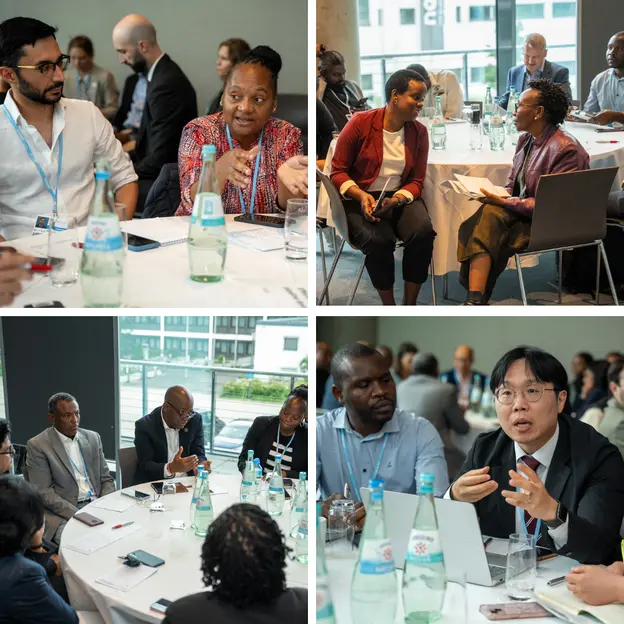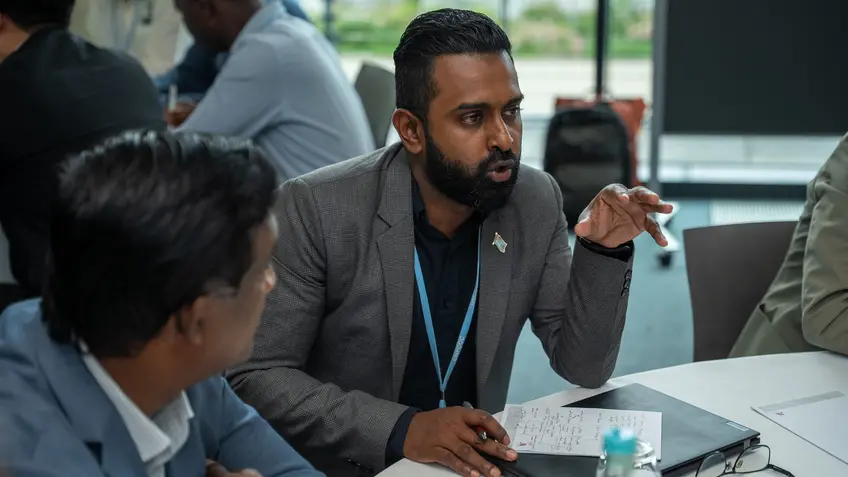Improving Access to Multilateral Climate Funds
Climate-vulnerable developing countries continue to face significant barriers in accessing the finance needed to drive transformational climate action — with challenges ranging from overcoming national capacity limitations to navigating the complex requirements set by funders.
To help overcome those challenges, the Center for Access to Climate Finance — hosted by the NDC Partnership Support Unit — organized a peer exchange event, during the 2025 Bonn Climate Change Conference (SB62) in Germany. The event brought together government officials and experts from the Adaptation Fund (AF), the Global Environment Facility (GEF) and the Green Climate Fund (GCF) to explore ways to improve access to multilateral climate funds, through both country-level actions and reforms to the climate finance architecture.
At the event, “Improved Access to Multilateral Climate Funds,” discussions — spanning country-level experiences to accreditation processes and proposal development — pointed to three key areas for strengthening access to climate finance:
1. Strengthening Countries’ Capacities to Access, Coordinate and Manage Climate Finance
Institutional bottlenecks often limit climate-vulnerable countries’ ability to navigate complex funding requirements. In response, many governments are taking steps to strengthen coordination and build institutional capacity. Two key areas of progress include:
Establishing or strengthening coordination mechanisms for climate finance:
Country-led platforms and climate finance units (CFUs) are helping to improve coordination across government, develop stronger investment plans and project pipelines and integrate climate considerations into national budgets and investment frameworks:
- Uganda’s CFU, established in 2023, has coordinated various climate finance flows to bridge the finance mobilization gap in line with national priorities. Examples of how the CFU has achieved this includes the development of a National Climate Finance Strategy, which is focused on mobilizing finance from all sources; the development of a National Green Taxonomy, which provides clarity in defining what constitutes sustainable investment; and the application of NDC Partnership’s Project Checklist to enhance Uganda’s national pipeline of bankable projects.
- The Brazil Platform for Climate Investments and Ecological Transformation (BIP), launched in 2024, is a good example of the next generation of country platforms: anchored in national priorities and strong governance arrangements, with a clear programmatic direction and implementation mechanisms to mobilize finance from multiple sources.
Obtaining readiness support through the AF, GEF and the GCF: Multilateral funds offer readiness support that helps countries strengthen institutional capacity and advance nationally led initiatives. This includes support for conducting needs assessments, establishing and strengthening coordination mechanisms and mobilizing investment.
2. Improving Fund-Specific Access and Efficiencies
Multilateral climate funds continue to streamline accreditation, project approval and disbursement processes to improve access and coordination at the country level. This includes:
Enabling direct access: Direct access allows climate finance to be channeled directly to national entities, strengthening country ownership and reducing transaction costs. The AF and GCF promote this approach through their national implementing entities (NIEs) and direct access entities (DAEs), respectively. Examples include:
- The AF has pioneered enhanced direct access (EDA), which involves devolving financial decision-making on adaptation to the national and subnational levels. It also promotes locally-led adaptation (LLA) through a funding window for LLA projects and programs.
- The AF NIEs and GCF DAEs both support a community of practice for direct access entities, providing an avenue for knowledge exchange, collaboration and peer support for accessing resources and implementing projects and programs through direct access.
Simplifying templates and streamlining reviews: Multilateral climate funds are introducing new efforts to assess and standardize internal processes to enhance transparency and improve information access. Specific examples include:
- The “Efficient GCF” initiative is enhancing operational efficiency and reducing the review time for new project requests to nine months by re-examining existing project reviews and approval processes.
- GEF similarly proposed a new set of streamlining measures to enhance and simplify policy requirements to ensure quality project review.
3. Enhancing Complementarity, Coherence and Collaboration Across Multilateral Climate Funds
To address the fragmentation in the climate finance architecture, multilateral climate funds are leveraging their respective strengths to evolve in a coordinated and integrated manner. Examples of progress include:
- Accreditation: The GCF and AF offer fast-track accreditation pathways for entities accredited by the other, reducing the administrative burden and expediting the process. The GEF is exploring a similar approach, as part of GEF-9, with a focus on Least Developed Countries (LDCs) and Small Island Developing States (SIDS).
- Joint programming: The Long-Term Vision (LTV) on Complementarity, Coherence and Collaboration between the GCF and the GEF aims to identify and pursue important common themes for climate action, seek opportunities for joint investment plan development, minimize duplication and streamline country consultation processes.
- Identifying synergies across projects: The AF and GCF are piloting a structured approach to scale up successful AF projects through the GCF. This increases the impact of successful interventions, reduces transaction costs associated with the proposal cycle and increases the sustainability of interventions.

A Path Forward for Climate Finance Access
Through the event, climate finance providers gained critical insights into where countries needed support to strengthen institutional and technical capacities, as well as opportunities to further harmonize and standardize climate finance processes. Looking forward, developing countries can use the resources provided here and the reflections offered at the event to better navigate climate finance from multilateral funds.
To support developing countries in navigating the climate finance landscape, the United Kingdom and Fiji, as initial Co-Chairs, launched the Taskforce on Access to Climate Finance in 2021, bringing together developing countries and bilateral and multilateral climate finance providers to identify and implement solutions to improve finance access.
Building on the work of the Taskforce, the NDC Partnership and the Government of the United Kingdom launched the Center for Access to Climate Finance (the “Center”) at COP28 in 2023 in response to demand from Taskforce members for an entity dedicated to generating and streamlining solutions to climate finance access. By facilitating exchanges around common challenges and solutions, the Center informs targeted actions to create a more collaborative system of international climate finance across three focal areas: knowledge sharing, system thinking and policy analysis and outreach.
Additional Resources
Further reading on the Center’s key findings and recommendations related to the multilateral climate funds can be found in the 2024 Annual Report of the Taskforce on Access to Climate Finance. For more information on CFUs, read the Center’s Policy Brief, “A Practical Guide to Understanding and Establishing Climate Finance Units.” This Policy Brief sheds insights on how to establish and effectively implement CFUs within governments and set up institutional frameworks that accelerate climate finance in alignment with national goals.
To learn more about the impact of multilateral climate funds, visit the Climate Project Explorer. This platform, jointly developed by the AF, GCF, GEF and CIF, serves as a single point of entry for navigating and exploring relevant documents.
